U.S. Department of Transportation
Federal Highway Administration
FHWA-SA-16-079
BACKGROUND
In rural areas, many communities are located along higher-speed roadways, but have much lower speed limits inside the city limits. Speed limits can often drop from as high as 55 mph down to 25 mph as the road feeds into the town's center where pedestrians and bicyclists are more common. Typically, changes such as on-street parking or a greater number of houses or businesses give visual cues to out-of-town travelers that speeds will be reduced. These roadside cues are not always enough though, and additional traffic calming measures need to be installed to help lower vehicle speeds as drivers enter town.
CHOOSING TRAFFIC CALMING TREATMENTS AND LOCATIONS
In 2012, several communities in Iowa employed a variety of traffic calming techniques to inform motorists of the reduced speed limits and encourage them to slow down. Located on higher-speed roadways with speeds dropping by as much as 30 mph, the towns of Hazelton, Quasqueton, Jesup, Ossian, St. Charles, and Rowley installed five types of low-cost traffic calming treatments (shown below).1 All of these communities had the common goal of improving safety and managing the speeds into their towns.
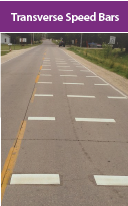
This pavement marking treatment creates a visual effect that encourages motorists to slow down. The bar placement guides motorists to direct the vehicle's wheels in gaps between the bars, which results in the driver unconsciously slowing down.
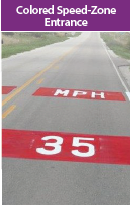
Colored or textured surface treatments in the roadway draw motorists' attention to changing roadway conditions.
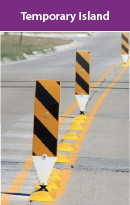
Temporary islands made of raised curbing and/or vertical markers can be removed and replaced, as needed, and give drivers the sensation of constricted lane widths, thus encouraging deceleration.
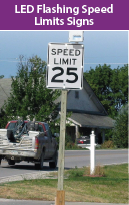
These speed limit signs have LED lights that are activated by motorists travelling above a set speed threshold, usually 5 mph or greater above the posted speed.
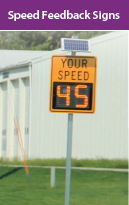
The speed feedback signs display the motorists' actual speed.
The communities' county engineers recommended the specific roadways and locations for the traffic calming treatments. With speed limits transitioning from 55 mph to as low as 25 mph, each of these roadways had safety and speeding-related issues. The following table shows the locations, speed limits, and specific treatments used in each community.
| COMMUNITY | ROADWAY | SPEED LIMIT TRANSITION | TREATMENT USED |
|---|---|---|---|
| Hazleton | County Road C-57 / Hayes Street | 55 mph to 25 mph | Transverse Speed Bars |
| Quasqueton | County Road W-40 | 55 mph to 25 mph | Transverse Speed Bars |
| Jesup | 220th Street / State Highway 939 | 55 mph to 35 mph | Colored Speed-Zone Entrance |
| Ossian | County Road W-42 | 55 mph to 25 mph | Colored Speed-Zone Entrance |
| St. Charles | County Road R-35 | 55 mph to 25 mph | Temporary Island |
| St. Charles | State Highway 251 | 55 mph to 25 mph | Temporary Island |
| St. Charles | State Highway 251 | 55 mph to 25 mph | LED Speed Limit Sign |
| Rowley | County Road D-47 | 55 mph to 25 mph | Speed Feedback Sign |
| Rowley | County Road D-47 | 55 mph to 25 mph | LED Speed Limit Sign |
POSITIVE RESULTS
In order to evaluate the effectiveness of these treatments in reducing speeds, the communities partnered with researchers to complete before and after studies. The table below summarizes the largest reductions for each type of traffic calming treatment considered.
| Treatment Used | Reduction in Excessive Speeds | Average Speed Reduction (mph) |
|---|---|---|
| Colored Speed-Zone Entrance Treatment | 100% | 2.3 |
| Speed Feedback Signs | 79% | 7.6 |
| Temporary Island | 71% | 2.6 |
| Transverse Speed Bars | 54% | 2.3 |
| LED Flashing Speed Limit Signs | 53% | 5.9 |
One year after the installations, the communities saw a decrease in average speeds. However, the most notable success for these treatments was the dramatic reduction in excessive speeders (vehicles traveling 15 mph or more over the speed limit). Overall, these traffic calming measures have encouraged lower speeds and reduced the most aggressive speeders, thus improving safety for the communities.
The most notable success for these treatments was the dramatic reduction in excessive speeders (vehicles traveling 15 mph or more over the speed limit).
FOR MORE INFORMATION
To view the complete research results for the speed management treatments installed in Iowa, access the report, Evaluation of Low Cost Traffic Calming for Rural Communities – Phase II [Updated], at: http://lib.dr.iastate.edu/intrans_reports/94/.
To learn more about speed management countermeasures, visit FHWA's Speed Management Safety website.
Also, check out FHWA's fact sheets: Speed Limit Basics and Speed Management: More than Just Speed Humps.
Page last modified on September 22, 2016
